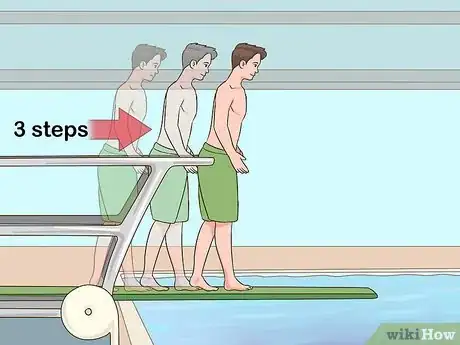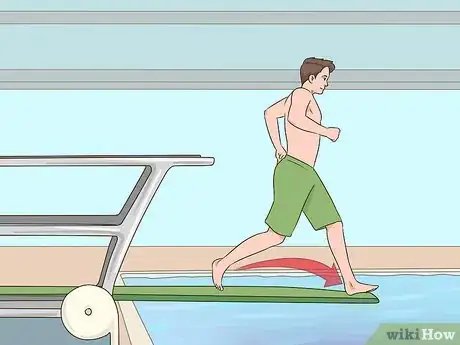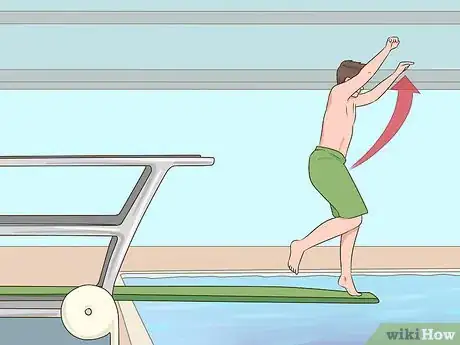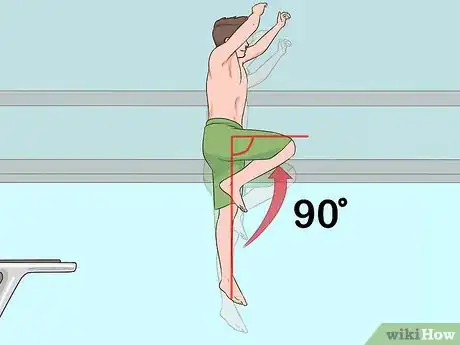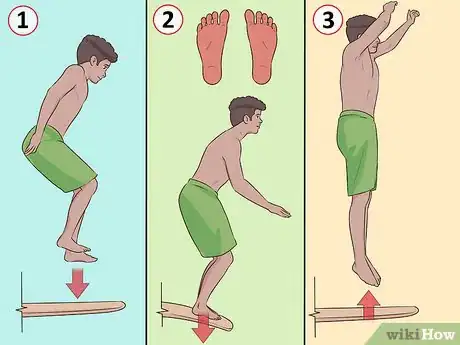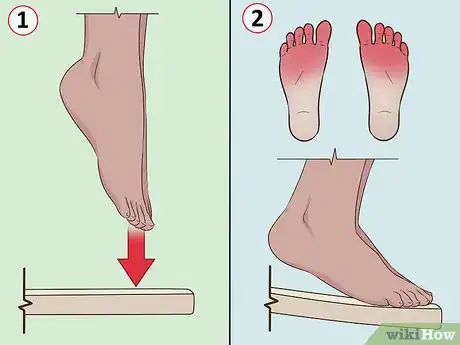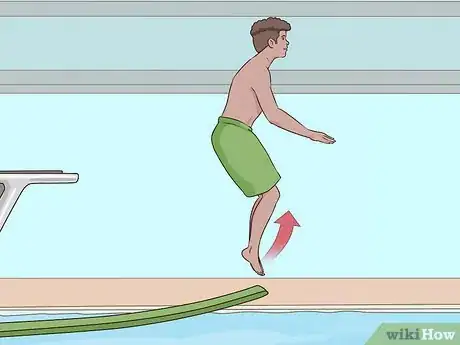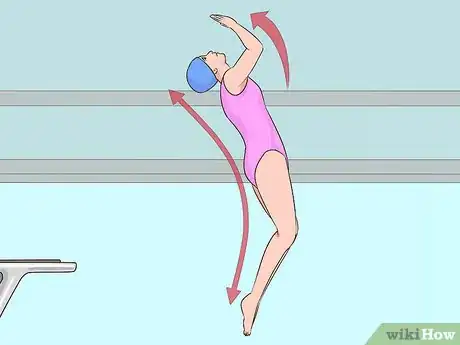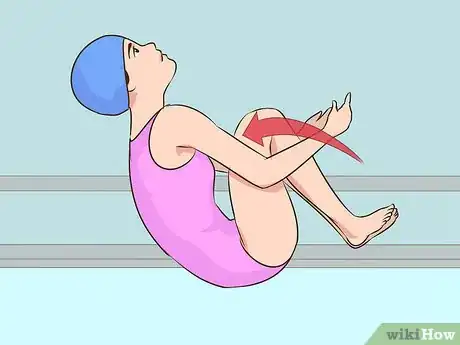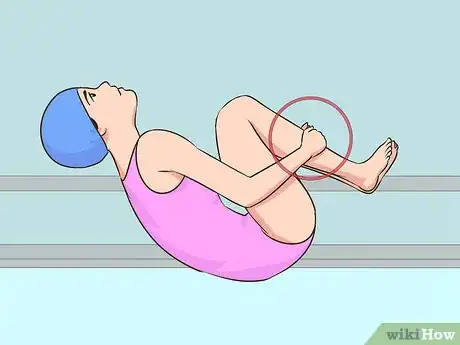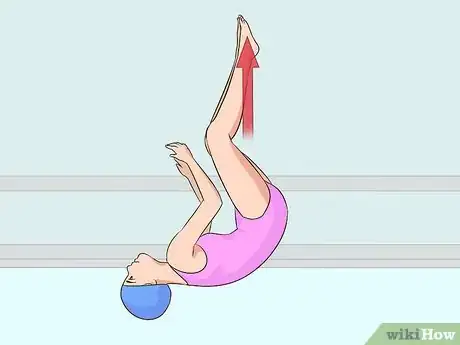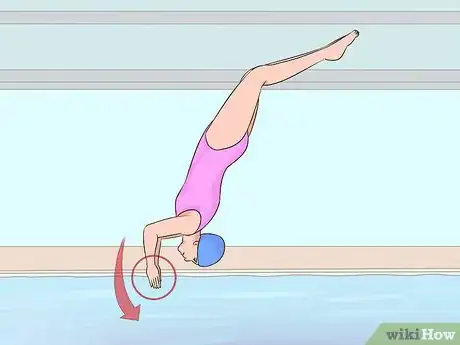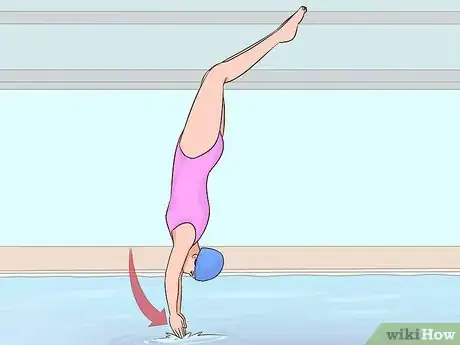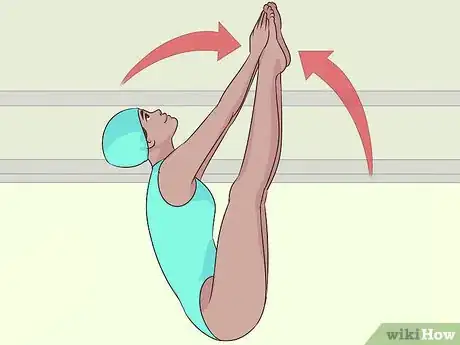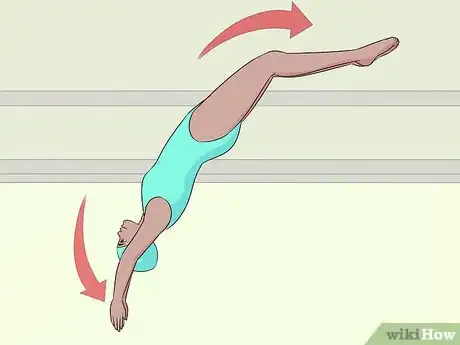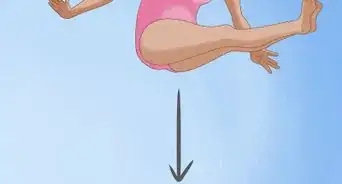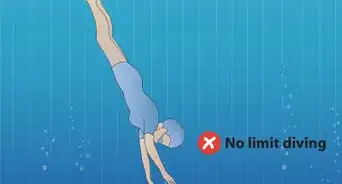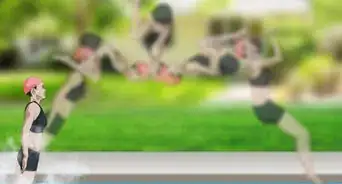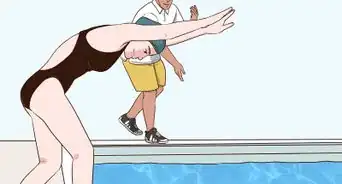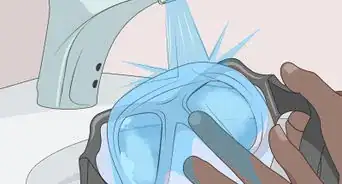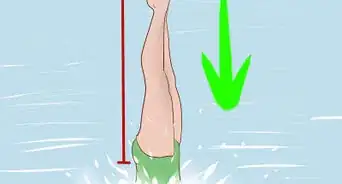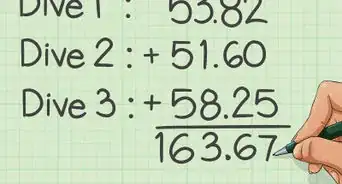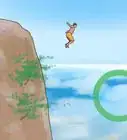This article was co-authored by Halle Payne, a trusted member of wikiHow's volunteer community. Halle Payne began diving at the age of 10. She coached the Brookwood Hills Bullfrogs' Dive Team from 2011-2013.
There are 10 references cited in this article, which can be found at the bottom of the page.
This article has been viewed 126,561 times.
Learn more...
A gainer is a daring reverse dive that starts as a forward-facing jump. In order to complete this dive successfully, you'll have to execute a perfect hurdle jump to gain momentum. Once you launch off the diving board, keep your body tight to pull off the reverse dive in good form. A gainer can be done with a tuck or pike formation depending on your preference and diving experience. To be safe, always do this dive in the presence of a coach or experienced diver.
Steps
Practicing Your Hurdle
-
1Take 3 steps forward from the back of the diving board. Keep your posture straight and move forward 3 regular steps, using the same stride you would for everyday walking. Move quickly enough to build momentum but not fast enough to slip and lose your balance. Space your steps so that your stronger foot plants last.[1]
- You may need to experiment to find the perfect starting point on the board. Typically, it should be about 5 steps from the end of the board.
-
2Take your press step. Your fourth step should be longer and more exaggerated than your previous 3 steps. It should bring your foot forward to the end of the diving board. Place your press foot flat on the board and bend your press leg to 90 degrees.[2]
- At the same time that your foot lands on the press step, bring your arms back behind you. You’ll be swinging them up above your head as you bend your leg.
Advertisement -
3Swing your arms upward and over your head. As you press down on your final step, bring your arms upwards in a counter-clockwise motion. Swing them upwards so your shoulders are next to your ears. They should be fully extended above your head.[3]
- You should feel the diving board depress at the point where your arms swing past your hips towards your head.[4]
-
4Jump and bend your other leg 90 degrees. Bounce upwards from your press foot, straightening that leg. Bring your other leg to a 90° position in the air from its already slightly bent position. Be sure to jump straight upwards without moving forwards or backwards.[5]
-
5Land with both feet on the end of the diving board and bounce back up. As you're still in the air, bring your bent leg downwards. Land on the end of the diving board with both feet. Use this landing to bounce back upwards.[6]
-
6Land on the balls of your feet. As you jump into the air, point your toes. Avoid landing heavily on your feet. Instead, land as softly as possible on the balls of your feet.[7]
-
7Swing your arms backwards in a circular motion and bend your knees. To correctly do a gainer, you should make these movements at the same time while you are landing. Swing your arms backwards as if you are drawing a large circle. While your arms move, bend your knees to a 90-degree angle as the board dips towards the water.[8]
- When the board is at its lowest point, your arms should have completed half of a complete circle and point downwards to the water. Your knees should be bent fully.
-
8Lift your arms and extend your knees as the board bounces upwards. As the board goes back up, continue swinging your arms forward in a circular motion in front of you and extend them as high as you can. Straighten your knees and let the board push you into the air.[9]
- When your arms finish the swing, your bicep should be pressed up against your ear. The swinging motion is important because it will help propel you forward off the board, which keeps you from going straight up and landing back down on the board.
- Keep your chin up during this step. This will also help to push you forward towards the water.
Completing a Reverse Dive Tuck
-
1Extend your arms past your ears as you move into the air. Once you are off the board, you will need to start creating momentum to start rotating backwards. Push your arms further back behind your head. This will arch your back, opening up your chest and pointing it towards the ceiling.
- This movement will start to rotate the body. If you focus carefully on what is in front of you, you should notice you are spinning because your view will be changing.
-
2Bring your knees to your chest as you jump. As you ascend upwards to face the ceiling, bring your knees towards your chest. Keep your toes pointed and your back straight. If you keep proper form, you are more likely to execute the reverse dive.[10]
-
3Place your hands on your shins as you do the tuck. A common misconception about the tuck position is that your arms should be hugging your knees. In fact, your arms should be pulled in at the sides of your body. Place your hands over the mid-part of your shins.[11]
-
4Extend your legs above you vertically. Allow the momentum of the turn to move you backwards. When your feet are above and you pointing toward the ceiling, let go of your shins. Begin to extend your legs upwards to point vertically.[12]
-
5Raise your arms and clasp your hands. After you let go of your shins, circle your arms out over your head to hug your ears. Bring your hands together and clasp them. Keep your arms straight and tight with your head planted firmly between them.[13]
- “Circling out” your arms keeps them in balance and prevents the movement of your arms from disturbing your body position.
- Your arms should be in line with your body when you enter the water.[14]
-
6Look at the water and dive in. Keep your head still but focus your eyes on the direction you are moving. When you see the surface of the water clearly, prepare to dive in. Close your eyes and keep your muscles tight and arms and legs fully extended as you enter.[15]
Completing a Reverse Dive Pike
-
1Bring your legs up to achieve the pike position. After your hurdle and jump off the board, use your core muscles to lift your legs upward toward your chest. Keep your legs straight and extended and your toes pointed. Aim to touch your toes to the tips of your fingers, keeping your arms extended above you.[16]
- Your body should be bent at the waist.
- Aim to bring your thighs as close as possible to your chest.
- Keep your back as flat as possible.
-
2“Unfold” the top of your body. After you reach the highest part of your ascent, start extending your upper body away from your legs. “Unfold” your body downwards to straighten out the V, and to angle your head towards the surface of the water. Avoid bending your head or neck backwards.[17]
-
3Bring your arms up the sides of your head. It is important to stretch your arms up as you “unfold” in preparation for the dive. As you shift your upper body towards the water, bring your arms up to the sides of your ears. Your arms should circle out to the side and then meet above your head.[18]
-
4Straighten out and complete the dive. Straighten your body out as much as possible before you breach the water’s surface. Extend your arms and legs and point your toes. Aim to enter the water in a straight vertical line.[19]
Expert Q&A
-
QuestionHow do you tuck dive?
 Halle PayneHalle Payne began diving at the age of 10. She coached the Brookwood Hills Bullfrogs' Dive Team from 2011-2013.
Halle PayneHalle Payne began diving at the age of 10. She coached the Brookwood Hills Bullfrogs' Dive Team from 2011-2013.
Former Diving Coach Keep your chest up as you jump. As you ride the board back up, bring your arms up to your ears. This will prepare you for the tuck and help you keep your chest upright. Wait until the height of your jump to tuck for the best results. Get to the peak of the jump, and then pull your legs up into the tuck.
Keep your chest up as you jump. As you ride the board back up, bring your arms up to your ears. This will prepare you for the tuck and help you keep your chest upright. Wait until the height of your jump to tuck for the best results. Get to the peak of the jump, and then pull your legs up into the tuck. -
QuestionHow do you get over the fear of doing this?
 wikiHow Staff EditorThis answer was written by one of our trained team of researchers who validated it for accuracy and comprehensiveness.
wikiHow Staff EditorThis answer was written by one of our trained team of researchers who validated it for accuracy and comprehensiveness.
Staff Answer wikiHow Staff EditorStaff AnswerTry mastering some simpler dives, first. Start by doing simple forward dives off a low diving board, then gradually work your way up to more complicated dives, like the gainer. You should also learn these dives under the supervision of an experienced instructor. They can teach you proper technique and help you get over your fear.
wikiHow Staff EditorStaff AnswerTry mastering some simpler dives, first. Start by doing simple forward dives off a low diving board, then gradually work your way up to more complicated dives, like the gainer. You should also learn these dives under the supervision of an experienced instructor. They can teach you proper technique and help you get over your fear. -
QuestionHow do I do a gainer if I have a shorter diving board?
 Community AnswerDo the same thing, just throw harder and tuck more by pulling your legs out in opposite directions.
Community AnswerDo the same thing, just throw harder and tuck more by pulling your legs out in opposite directions.
Warnings
- Only attempt this dive under supervision of a diving coach or experienced diver.⧼thumbs_response⧽
References
- ↑ https://d3tb2mkdocc4em.cloudfront.net/recreationfacilities/wp-content/uploads/sites/25/2017/01/Monthly-Manager-Moments-Article-13.pdf
- ↑ https://d3tb2mkdocc4em.cloudfront.net/recreationfacilities/wp-content/uploads/sites/25/2017/01/Monthly-Manager-Moments-Article-13.pdf
- ↑ https://www.youtube.com/watch?v=9XQE1lqWLAg&feature=youtu.be&t=70
- ↑ https://d3tb2mkdocc4em.cloudfront.net/recreationfacilities/wp-content/uploads/sites/25/2017/01/Monthly-Manager-Moments-Article-13.pdf
- ↑ https://www.youtube.com/watch?v=E6LKkyGYrfU&feature=youtu.be&t=45
- ↑ https://www.youtube.com/watch?v=E6LKkyGYrfU&feature=youtu.be&t=49https%3A%2F%2Fwww.youtube.com%2Fwatch%3Fv%3DLr9j1kSjzb4
- ↑ https://d3tb2mkdocc4em.cloudfront.net/recreationfacilities/wp-content/uploads/sites/25/2017/01/Monthly-Manager-Moments-Article-13.pdf
- ↑ https://cmdldiving.files.wordpress.com/2014/05/coach-packet-2014.pdf
- ↑ https://www.youtube.com/watch?v=2FMOSfryKto&feature=youtu.be&t=25
- ↑ https://d3tb2mkdocc4em.cloudfront.net/recreationfacilities/wp-content/uploads/sites/25/2017/01/Monthly-Manager-Moments-Article-13.pdf
- ↑ https://www.youtube.com/watch?v=G9is53XgR8k&feature=youtu.be&t=36
- ↑ https://d3tb2mkdocc4em.cloudfront.net/recreationfacilities/wp-content/uploads/sites/25/2017/01/Monthly-Manager-Moments-Article-13.pdf
- ↑ https://cmdldiving.files.wordpress.com/2014/05/coach-packet-2014.pdf
- ↑ http://news.bbc.co.uk/sport1/hi/olympics/diving/3103909.stm
- ↑ https://d3tb2mkdocc4em.cloudfront.net/recreationfacilities/wp-content/uploads/sites/25/2017/01/Monthly-Manager-Moments-Article-13.pdf
- ↑ https://www.youtube.com/watch?v=XNwGZBriB7w&feature=youtu.be&t=40
- ↑ http://thediagram.com/15_2/standingreverse.html
- ↑ https://cmdldiving.files.wordpress.com/2014/05/coach-packet-2014.pdf
- ↑ http://thediagram.com/15_2/standingreverse.html
